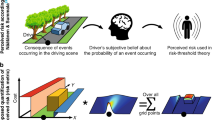Abstract.
The data presented here show that human drivers apply a discrete noisy control mechanism to drive their vehicle. A car-following model built on these observations, together with some physical limitations (crash-freeness, acceleration), lead to non-Gaussian probability distributions in the speed difference and distance which are in good agreement with empirical data. All model parameters have a clear physical meaning and can be measured. Despite its apparent complexity, this model is simple to understand and might serve as a starting point to develop even quantitatively correct models.
Similar content being viewed by others
References
D. Chowdhury, L. Santen, A. Schadschneider, Phys. Rep. 329, 199 (2000)
D. Helbing, Rev. Mod. Phys. 73, 1067 (2001)
K. Nagel, P. Wagner, R. Woesler, Oper. Res. 51 681 (2003)
E.P. Todosiev, L.C. Barbosa, Traffic Engineering 34, 17 (1963/64)
R.M. Michaels, Proceedings of the second international symposium on the theory of road traffic flow, 44–59, OECD (1963)
G.S. Gurusinghe, T. Nakatsuji, Y. Azuta, P. Ranjitkar, Y. Tanaboriboon, Transp. Res. Rec. 1802, 166 (2003)
R.J. Cowan, Transp. Res. 9, 371 (1976)
T. Luttinen, Transp. Res. Rec. 1365, 111 (1992)
M. Brackstone, M. McDonald, Transp. Res. F 2, 181 (2000)
I. Lubashevsky, P. Wagner, R. Mahnke, Euro. Phys. J. B 32, 243 (2003)
I. Lubashevsky, P. Wagner, R. Mahnke, Phys. Rev. E 68, 056109 (2003)
B.S. Kerner, The Physics of Traffic (Springer, Berlin, Heidelberg, New York, 2004)
B.S. Kerner, S.L. Klenov, J. Phys. A 39, 1775 (2006)
Next Generation Simulation Programme, http://ngsim.camsys.com/, accessed January 2006
T. Toledo, Integrated driving behavior modelling, Ph.D. thesis, MIT (2003)
Author information
Authors and Affiliations
Corresponding author
Rights and permissions
About this article
Cite this article
Wagner, P. How human drivers control their vehicle. Eur. Phys. J. B 52, 427–431 (2006). https://doi.org/10.1140/epjb/e2006-00300-1
Received:
Published:
Issue Date:
DOI: https://doi.org/10.1140/epjb/e2006-00300-1




